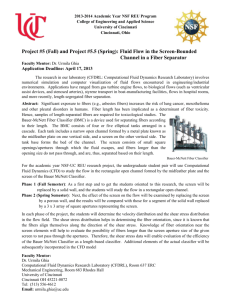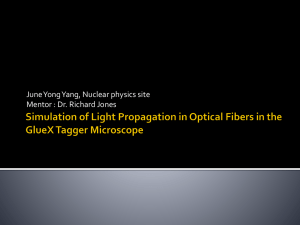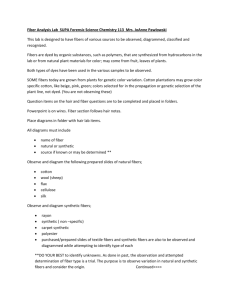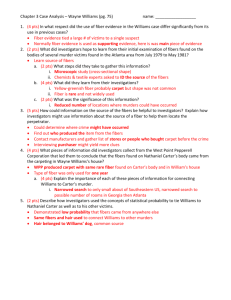Twisting Fiber Experiment
advertisement
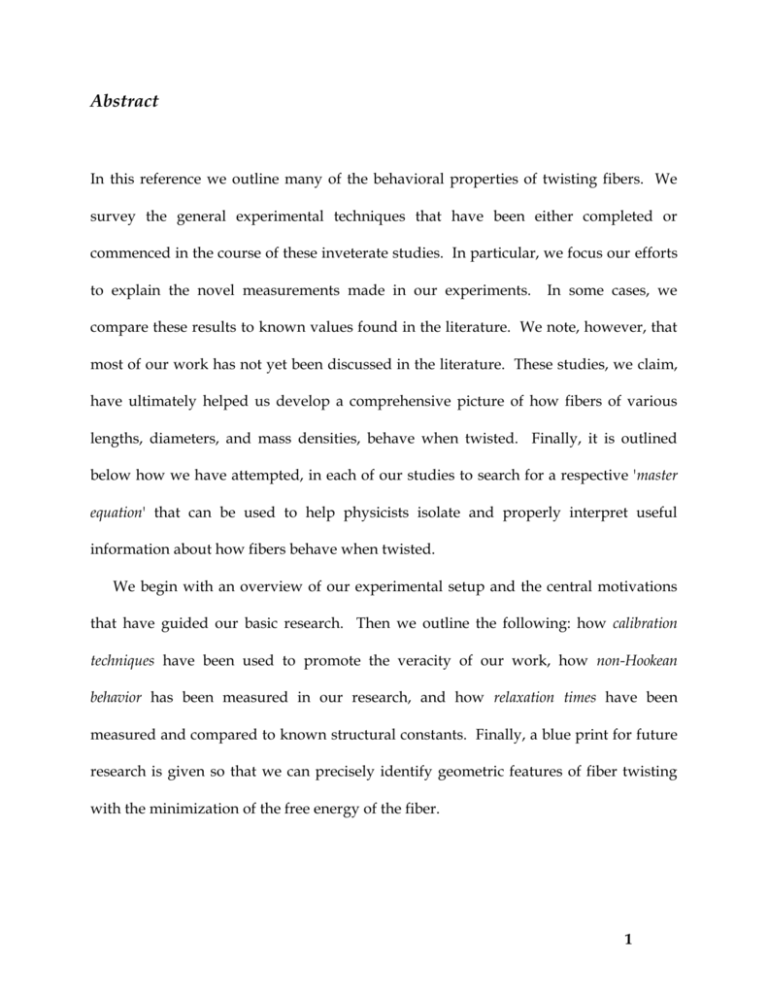
Abstract In this reference we outline many of the behavioral properties of twisting fibers. We survey the general experimental techniques that have been either completed or commenced in the course of these inveterate studies. In particular, we focus our efforts to explain the novel measurements made in our experiments. In some cases, we compare these results to known values found in the literature. We note, however, that most of our work has not yet been discussed in the literature. These studies, we claim, have ultimately helped us develop a comprehensive picture of how fibers of various lengths, diameters, and mass densities, behave when twisted. Finally, it is outlined below how we have attempted, in each of our studies to search for a respective 'master equation' that can be used to help physicists isolate and properly interpret useful information about how fibers behave when twisted. We begin with an overview of our experimental setup and the central motivations that have guided our basic research. Then we outline the following: how calibration techniques have been used to promote the veracity of our work, how non-Hookean behavior has been measured in our research, and how relaxation times have been measured and compared to known structural constants. Finally, a blue print for future research is given so that we can precisely identify geometric features of fiber twisting with the minimization of the free energy of the fiber. 1 OVERVIEW 1 Introduction Anyone who has ever twisted a fiber will notice many of the properties that we investigate. Moreover, these properties, i.e., measurable quantities like torque, tension and geometrical deformations, scale appropriately for nearly all fibers of any length, diameter, or mass density. Electrical cables, elastic cords, musical instrument strings, telephone wires, plant fibers, plastic fibers, and various hoses and tubes, all exhibit similar properties; they differ only by specific scaling factors, like length, diameter, and Young's modulus. The internal stresses and strains ultimately manifest themselves in the geometrical deformations that one can actually see and feel when twisting a fiber. For instance, if a fiber of length L is taken between the thumb and index fingers of both hands as shown in [Fig. 1] and then twisted one will immediately notice a torque and tension acting on the fingers. The torque will act in such a way to restore the fiber into its natural, untwisted state. The tension will act in such a way to pull the ends of the fiber together. If one shortens the fiber, i.e., relaxing the tension now felt by the hands, then something remarkable happens. The twisting has caused internal strains in the fiber, which report back to the twister's fingers a complex amalgamation of external stresses and strains. Relaxing the tension causes the fiber to deform into, what we call, a simple helix, as shown in [Fig. 2]. If the ends are brought closer together, the helix 2 tightens and "snaps" into a twist or snap helix, as shown in [Fig. 3]. This snap helix occurs rapidly and has a strong tendency to form perpendicularly to the initial fiber axis. Our experimental setup, as shown below [Fig. 4], is based on measuring what can be felt and seen in the observation described above. Primarily, we measure the torque (twisting induced strain perpendicular to fiber axis) and tension (twisting induced endto-end force along fiber axis) resulting from the twisting of a fiber through a certain angle, , where = 2·turns/unit length. We also measure several dynamical characteristics as a result of the twisting, including the tension and torque as a function of change in length, L. In quantifying what we know others see when reproducing our experiments, it is necessary, as was done above, to define many of the crucial characteristics that we notice when twisting fibers. Other crucial terms, not defined above, but used throughout this paper (and our research) include: beads: these are the constituent twists that can be discretely counted in a snap helix (see Fig. 3); relaxation: this is a temporal measurement of the tendency of a fiber to return to its original untwisted state; the relaxation of a fiber is usually measured between or after twisting has occurred (see Plot 7 & Plot 8), but can also be measured during twisting (see Plot 4). Non-Hookean behavior: this behavior is measured when a pre-twisted, straight fiber has its ends brought slowly together, so that a simple helix forms and 3 then a snap helix. In the course of this evolution, it is noted that tension in the fiber increases when it is expected to decrease--opposite of Hooke's Law (see Plot 8). With these definitions, we proceed to quantify what anyone can observe by twisting a fiber. Each of our experiments is performed so that we can identify how fibers behave and maybe learn a little bit about why they behave the way they do. Below we list the motivations of why we think this problem is physically and mathematically important to study. 2 Motivations The motivation to study the behavior of twisting fibers is threefold. First, both natural and artificial fibers are ubiquitous in our everyday observations. In particular, we are forced to recognize that fibers, their interactions, and behavioral dynamics play a crucial, if not fundamental, role in many of the physical mechanisms that govern the natural selection processes exploited by biological organisms. The vast majority of cellular material fall under the classification of fibers. That is, in principle, many of the species of cellular and sub-cellular structures can be modeled as a single fiber or a set of fibers. Dynamical models, of course, generally simplify the action of these fibers as simple springs or harmonic oscillators or torsional rods. We use these same models to manifestly simply our work so that reliable predictions can be obtained from a minimum number of measurements. One of our ultimate goals is to find connections between the macroscopic dynamics of fibers with those of microscopic strains and 4 stresses now being measured with optical tweezers in materials like DNA and other chromatin material. Similarly, we also recognize that there are numerous basic research applications that utilize artificially produced fibers. By learning some of the universal characteristics about how these types of fibers behave when twisted, we can learn how to manufacture fibers whose properties can be selected more precisely and more craftily to meet the needs of the fibers’ uses. Secondly, we recognize that in the course of our studies that many unexpected results have impressed us enough to force us to think that more work needs to be done to uncover how various parameters, like torsion, stress, or strain, should evolve in the course of twisting fibers. These outstanding observations are presently the impetus for several research programs which we are concurrently running experiments in order to find different techniques that measure the same physical parameters, like the modulus of elasticity or Young’s modulus. And lastly, in performing our experiments, we recognize that the dynamics of a twisting fiber resemble the behavior of living organisms. In particular, when elastic fibers are twisted they display an uncanny resemblance to the reactions observed in many biological organisms adapting to their environment. For comparison, elastic fibers can react quite violently when heated—in essence they generally shorten, rather than lengthen, and consequently, reduce their entropy. Observations like these have provided abundant incentives to quantify the dynamics of these fibers so that we may, in principle, understand some of the fundamental connections between physical and 5 biological phenomena. Using this sort of reductionist picture, there is a realistic potential for substantial gains in our understanding of how certain microscopic biological mechanisms can manifest themselves in the macroscopically observable behavior that we measure. Below, we outline a number of central tenets that have re-enforced our motivations and directed our research program in beneficial ways. 2.1 Natural Phenomena In life, as in nature, nothing is rigid. This universal result is not only demanded by special relatively, but consequently, realized as a fundamental result of the atomic hypothesis, which states that the stuff we are made of is (for our purposes) atoms and atoms are, at short distances, essentially attractive but at even shorter distances they become repulsive. Nature (and life) must exploit this crucial property of matter in order to build macroscopic objects whose dynamical behavior simulate the same mathematics of simple harmonic oscillators or sometimes called Hooke’s law. Natural selection, then, must also perform its duty according to these physical laws. In this way, all biological organisms should be studied, at least from this distinct point of view, as though they are fundamentally composed of tiny harmonic oscillators. Our present research is, in principle, not far removed from this discriminating picture life. In the lab we observe elastic fibers under stress and strain and we model and interpret their behavior as a complex collection of springs with modifiable parameters that can be used to predict the behavior of all fibers, natural or unnatural. 6 Since we do not deal directly with living tissues, we are at risk of losing this ostensibly tenuous connection between our work and the dynamics of living organisms. However, we are inspired by the results we have obtained and consider that much of our work can and should be compared to behavior observed in biological systems. From a pragmatic point of view, we have not experimented with natural or biological fibers. Instead, we use artificial fibers for several reasons. First, artificial fibers are easy to obtain from the standard industrial production of fish line and trimmer line. These types of fibers have fairly reliable properties. Namely, their diameters are usually consistent to within three thousands of an inch (or eight thousands of a centimeter) and their mass density (per unit length) is consistent for a given fiber. What is not yet known is whether the fiber’s used have internally consistent properties, i.e., it is not known if there are particular manufacturing processes that would drastically alter the result of our measurements if the production of the fibers were slightly or dramatically modified. It is our assumption, however, that such an inconsistency would and should not be present in these fibers, since it is not a beneficial property of the fibers to be made inhomogeneously. In fact, we argue that it is difficult to construct fibers with inhomogeneous properties. Second, we use artificial fibers precisely because of their assumed homogenous properties. Because we are searching for relationships, that we believe, have not yet been quantified, we are using very simple fibers whose properties are very well defined. Lastly, we do not use natural fibers because they are generally more expensive and not readily available. Natural fibers tend not to be homogenous and are also, in many cases, ‘predeformed’ in 7 such ways that studying them becomes impossible. Similarly, we do not yet possess the machinery to study these fibers: our set-up has been established to study the behavior of specific types of fibers, whose diameters’ and lengths’ are macroscopic (5 –100 cm and 150 microns – 2.5 mm, respectively), and whose elasticitys’ are comparatively equal. 2.2 Modeling And Interpolation In our present studies we have two aspirations for modeling and interpolating the results of our experiments which we address here. Unfortunately, we have come short in accomplishing either of our primary goals. By no means, however, are we precluded from obtaining either of these goals. Our main obstacles, so far, have included reconciling unmatched calibration data with theory and following up 'loose-end' research which we generally consider, comprehensively speaking, important though not central to our basic research programs. Our first aspiration has been to identify microscopic effects by measuring macroscopic quantities. This is a simple research program but it is not without its problems. First, we have been unsuccessful at finding direct quantitative links to theoretical models which would corroborate our data with microscopic effects. In truth, very few theoretical calculations have been done for elastic fibers, making our task all the more difficult to accomplish. Nevertheless, we believe, in the long term, our research programs will succeed at finding a correlation between the microscopic internal forces with the macroscopic forces measured using our apparatuses. 8 Our second aspiration has been to develop a set of 'master equations' that help us isolate and properly interpret crucial information about the internal forces within the fiber. These 'master equations' provide us the ability to predict how a fiber will react in a specific manner when twisted or relaxed or allowed to contract. In each case, we have attempted to isolate a number of measurable parameters with one or two unknowns to be solved. The genesis for many of these equations comes to us, primarily, by way of two methods. Directly, we can work out basic mechanical equations, as is the case of torsion due to twisting fibers, and less directly with dimensional analysis. In some cases we simply cannot work out, from first principles, the dynamics of the fibers. In these cases, we look for relationships, like exponential decay, whose familiar solutions help us identify fiber constants, like decay constants, with experimental unknowns, like Young's modulus. Looking ahead, we will plan to build several other types of experiments that exploit the construction of formulas whose constants can reveal important experimental unknowns from measurable parameters. In this way, the techniques we use and develop are equally as important as the data we retrieve in each experiment. Together these aspirations form the basic connection with theory. In the long run, we hope to establish direct connections with statistical and thermal physics. In particular, we hope to develop a model or several models that, in the style of condensed matter research, would relate the geometry of distortions in the fibers due to twisting, with the free energy of the fiber. These are long range goals are ambitious, but we believe 9 they are realizable. More importantly, we believe that these sorts of theoretical steps must necessarily be taken if we are to accomplish our first aspiration. There are two caveats, however, that we must state concerning our idealized aspirations. First, the specific behavioral features we measure in many of our experiments are inherently non-linear. That is to say, some of the simplest experiments we run cannot be expressed in terms of first principles, but must be viewed as a perturbative expansion with appropriately non-trivial solutions. Historically speaking, physicists have been prejudiced against nonlinear systems, in that they have no simple solution nor can they be identified with any sort of universal geometry. Recently, triumphant efforts have been made, certainly in the field of chaos and non-linear dynamics, which have only modestly succeeded in demonstrating predictions for behavior of previously thought insoluble problems. Nevertheless, many of our experiments run themselves very close to the point where these so-called non-linear effects are simply too calculationaly burdensome to overcome. On the other hand, we have been quite successful at realizing when our simple experiments break down, and it is just as important, in all cases, to know what the limits of our knowledge are. To quote, Mitchell J. Feigenbaum, the modern father of chaos theory, "No real spring is linear". Touché. Second, in generalizing microscopic details in the bulk of our macroscopic measurements we are in danger of forbidding ourselves the pertinent information about the microscopic details we set out to recover. But this is partly a conundrum. The essential problem of statistical thermodynamics, to quote Erwin Schrödinger, is to 10 discover the given amount of energy, E, over N identical particles. By this we not only assume that interactions are weakly coupled and can be disregarded, but that we cannot explicitly know anything about those interactions. In other words, the private energies between microscopic particles is necessarily lost. Does this remove the credulity in our first aspiration? Are we fixed only to describe macroscopic features whose connections to microscopic details are necessarily cut? The simple (and short) answer is: it might not be important. Our research programs may never evolve to the stage where it can consider handling those types of questions anyhow. Whatever the outcome of our attempts to manufacture, compare, or embellish theoretical models, the process of experimentation will not go without its rewards. The primarily motivation for this research is summarized here: we are measuring things that cannot be calculated. This is not the first time, i.e., atomic spectra were known a whole generation before their explanation was given, and this shall not be the last time experiment precedes theory. We are simply exploring what we know exists. RESEARCH DIRECTIONS 3 Experiments and their Ends 11 The completion of an experiment is a frightful thing. In many cases the experimenter does not know a lump of gold from a lump of pyrite. It is the duty then of the experimentalist to search his or her toolbox of intuition, savvy, and pragmatic thought in order to know implications of his or her knowledge of the experiment. Below, we list the three primary directions that have helped guide our basic research from falling into traps of ostentation and improbity. First, we describe calibration techniques used. Calibration is the tool which physicists use to defend all of their observations. It is the instrument by which all comparisons can be justifiably made. Second, we list a (incomplete) selection of novel experiments performed. And lastly, we point out where our future research is headed. 3.1 Calibration There are many levels of corroboration between theory and experiment. In some cases, we learn 'late-in-the-game' that the theory that was once thought applicable is no longer valid (or even worse—never valid!). Or we learn, as proud humans, that our experimental set-up is inadequately or unskillfully set-up . By calibrating our equipment we hope to remove the possibility of either of these scenarios from frustrating our work's intention. Calibration occurs during many points in the research program. First, we calibrate every pertinent measuring device, traceable to the NIST (National Institute for Standards and Technology; formerly NBS, National Bureau of Standards). Second, if possible, we 12 calibrate (corroborate) a single measurement with a known or predicted theoretical value. We do both, but have only been successful in limited cases. Since only one strain gauge is primarily used, its calibration is paramount to our findings. Indeed, it is well calibrated for the weight of objects given our experimental set-ups, i.e., it can measure force to an accuracy of at least two decimal places. On the other hand, other experiments have been run to determine the efficacy of our experimental set-ups or rather how well torsional rod theory purports to predict the behavior of thin elastic fibers. These results have proven less auspicious. These experiments are run specifically to compare our data directly with the results of calculations done for torsional rods. Here, we list two pertinent results for both tension, T, and torsion, , measured from a fiber that is being twisted: T 1 C 2 2 C where = (2·turns/unit length) and C is sometimes called the torsional rigidity. Assuming these relations hold for our elastic thin fibers and given our experimental findings we should be able to identify C. Unfortunately our findings are only sporadically successful, with no clear evidence that we have either negated the validity of this particular theoretical comparison or that our set-up requires extensive renovations. There are many other examples of calibration experiments that have been run, most of them have to do with scaling or allometry. In general, we find that fibers whose 13 lengths are increased by integral amounts must also be 'twisted' by those same integral amounts in order to obtain the same result. We call this the twist-per-unit-lengthassumption or hypothesis: it simply (and physically) means that fibers are homogenous and that each twist affects each unit length the same. Though these sorts of studies may seem superfluous, they cannot go undiscovered or left as assumptions without testing. If we are to make these assumptions they must be justified. 3.2 Novel Experiments In the course of experimentation we have run into many interesting artifacts that belittle our attempts to make an experiment simple (remember the pyrite and the gold!). As experimentalists, we discriminate between the voices in our heads that lead us to the fool's gold or the argosy of apprehensible evidence. But the difference between an unexplained artifact and one that is explained, is, in many cases, a superfluous distinction—or a semantic distinction only. Our novel experiments have followed these so-called gray areas of research—to what end? Here there is danger (of losing a month's worth of experimental time!), but also the possibility of immense reward. We choose to investigate these avenues largely because we have nothing to lose (except time!) but also, as stated above, in many cases, only experiment can reveal any quantitative features to what we see. Present novel experiments include: hysteresis, relaxation, and observation of nonHookean behavior among others. Each of these studies is yet to be concluded and is 14 reported below, only in the form of a plot that depicts the general behavior of each experiment respectively. 3.3 Comparisons to Theory Probably the most difficult task that lies ahead is the search for fundamental connections between our experimental data and thermodynamic quantities, like the free energy of a fiber. The discovery of a connection, if any, between free energy and the geometrical features produced by the twisting process will be truly profound. It is fundamentally astonishing to us that Nature has chosen to minimize the energy of a twisted fiber by means of transforming the fiber from a line to a helical structure. (Even more astonishing is that Life has exploited this helical structure to contain vast amounts of information in seemingly impossible small spaces!) GENERAL BEHAVIOR 4 Gallery of Experiments and Results Below we have briefly described some the specific details of some of the major recent experiments. Below these descriptions are plots of these experiments. In some cases, the plots are taken from raw data, in other cases, the plots are either real data that has been analyzed or an amalgamation of data which accurately depicts the specific features 15 of a particular experiment. Choices for each plot are based on the need to illustrate overall experimental findings, they are not meant to obfuscate or conceal experimental errors. 4.1 Calibration • Weight Calibration (Plot 1) Here, we calibrate our strain gauge with a known weight (paper clips) to show that there is no drift in our measuring apparatus. In this calibration experiment, we ran two overlapping measurements, one that increased weight and another that decreased the weight. We found that there was no drift, as shown below, and that strain increased monotonically. • Turns/ Unit Length (Plot 2) In this experiment, we measure the number of turns just before a fiber snaps. We perform the experiment several times with different weights, only to find the outcome is unchanged. Here we plot turns per length. The graph below shows that this relationship is nearly exactly linear— hence our twist-per-unit-length-hypothesis is affirmed. • Torque/ (2·Turns per Unit Length) (Plot 3) In this experiment, we measure the torque on a fiber due to twisting. From this measurement we determine a value for the torsional rigidity, C. Below, we have plotted a typical value for a fiber of a given length. In 16 each experiment, we note that the torque depends linearly on turns. This is exactly what theory predicts. • Tension/(2·Turns per Unit Length)^2 (Plot 4) In this experiment, we measure the tension on a fiber due to twisting. From this measurement we determine yet another a value for the torsional rigidity, C. For comparison, we have plotted below, a typical value for a fiber of a given length (same as above). In each experiment, we note that the tension depends on the square of the turns. This is exactly what theory predicts. (Note the relaxation in the fiber due to internal elastic strain in the fiber. This relaxation is not detectable in small diameter fibers, i.e., fibers with 0.03-inch diameters or less.) 4.2 Turns per Weight (Plot 5) In this experiment, we measure the number of turns it takes before a fiber snaps into a helical structure for a given weight. The length of the fibers used is fixed, since we assume the twist-per-unit-length-hypothesis. Below we have reported a typical plot of this fundamental relationship. 4.3 Beads per Length (Plot 6) In this experiment, we measure the number of helical beads that appear due to twisting fibers of various lengths with various weights. These socalled beads are the countable twists in the helical structure after snapping. It should be noted that this particular behavior is sharply dependent on where a fiber decides to snap; i.e., the snap can be collet 17 constrained. In general, though, the short fibers tend to "snap" in the center of the fiber, whereas, longer fibers tend to be effected by gravity and are consequently forced to snap closer to the bottom collet. 4.4 Relaxation (Plot 7) In this experiment, we measure the relaxation of a fiber after it has been twisted as a function of time. In this particular experiment, only tension has been measured. Future experiments will include torque measurements. Below is a typical plot of this behavior. 4.5 Non-Hookean Behavior (Plot 8) In this experiment, we measured the tension on a fiber due to twisting as a function of bringing the fiber ends closer together. In this particular experiment we were surprised to find that the tension did not obey Hooke’s law. Below is a typical plot of this behavior. The history of the dynamics are given below: (see Fig. 1-3 for references to L, L', and L*) A As twisting occurs, L = 0, i.e., the length is kept fixed, but the tension increases quadratically (see Plot 4), B Twisting is stopped by the experimenter and a slight relaxation in tension occurs (see Plot 7), C The distance, now L', between the ends of the fiber decreases and the tension decreases and a simple helix develops (see Fig. 2), 18 D At some length, L' < L, but greater than L*, the tension increases again; a result which is opposite of Hooke's law, E As the length approaches L*, the tension increases and the snap helix develops until the twist forms (first spike), F A second spike occurs due to the slipping of the twist; consequently several other spikes occur for the creation of each bead in the snap helix. 19


